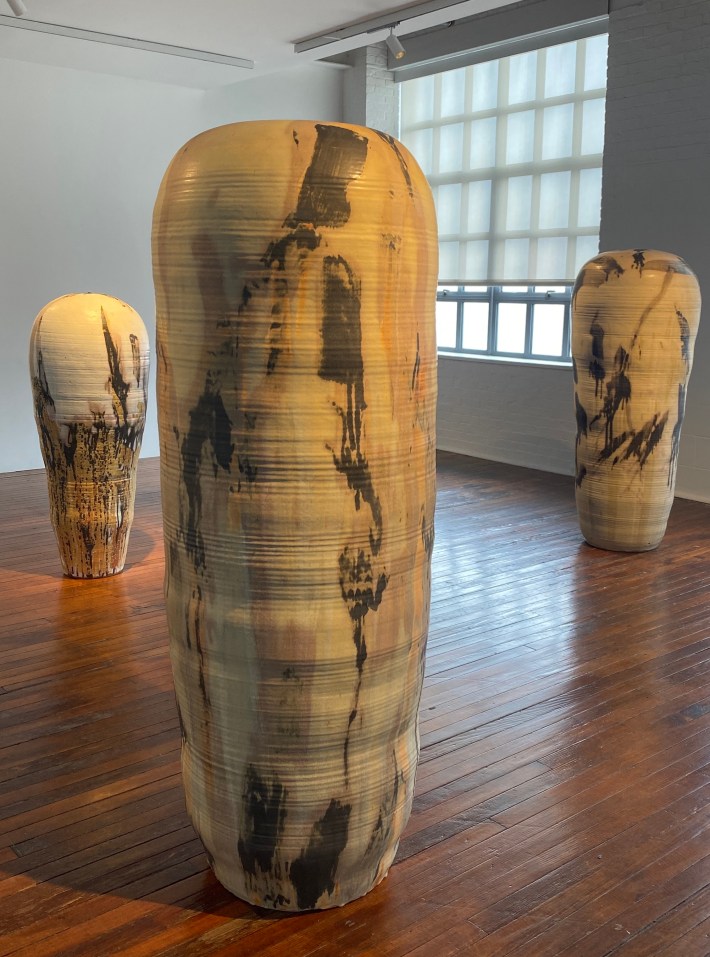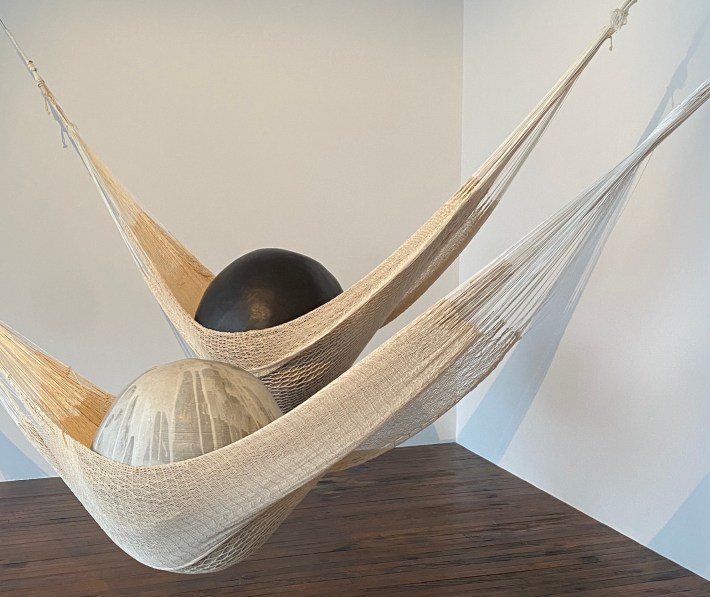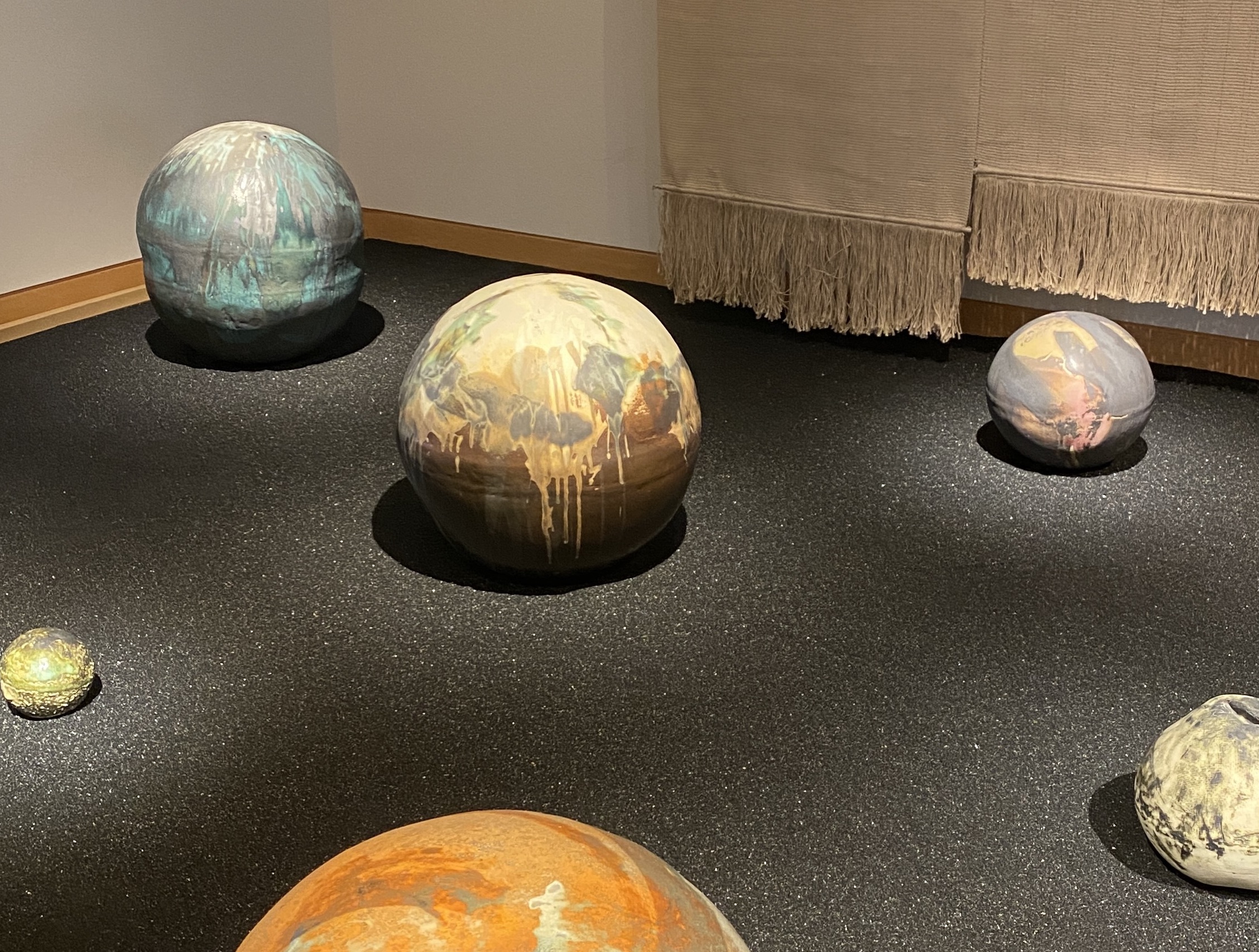Starting in the 1960s, the artist Toshiko Takaezu would sometimes enclose secrets inside her ceramics—enormous closed vessels with domed tops and pinhole openings, dripping in color. The idea came to her by accident, when a small piece of clay fell into one of her closed forms and continued rolling around the pot after it was fired, creating a rattling sound. Inspired, Takaezu began intentionally crafting rattles for her ceramics, designing some to sound like grasses crinkling in the wind or waves crashing on shore. She occasionally wrote messages inside the pot that she did not want anyone to read, not necessarily for their content (one of her messages was simply "peace") but rather, it seems, out of respect for the vessel's interiority. When Takaezu sealed off her closed ceramics, everything they enclosed—the rattles, the messages, the space—became inaccessible to us, or at least to our eyes.

The experience of encountering one of Takaezu's pots feels charged by these mysteries. Last weekend, at "Toshiko Takaezu: Worlds Within," a new retrospective of the artist's work on display at the Isamu Noguchi Foundation and Garden Museum in Queens, N.Y. through July 28, I wandered between Takaezu's "Star Series," a grouping of her signature closed forms displayed evenly spaced in a room, almost like a solar system. As I walked between the vessels, some of which were taller than me and splashed in sunsets of paint, I felt like a small moon in their orbit. I kept wondering about the dark space inside the pots, the thickness of their walls and their weight, if they had swallowed any secrets before the firing. (The notion that any pot this large and enclosed could emerge from a kiln intact seemed a miracle of its own.)
Takaezu was herself transfixed by the space inside her forms. When she threw them, she had to stand on a six-foot-tall scaffold, assisted by a helper running the wheel's pedal down below. "It's very slow but it's moving, and I felt all this beckoning to drop into the pot," Takaezu said in a 2003 interview with Gerry Williams for the Archives of American Art at the Smithsonian. "You, yourself, to drop into the pot?" Williams asked. "Yes, I wanted to go in the pot itself," Takaezu said. "You can feel the pounding of your heart. It was beating, because it's a frightening experience that, you know, you want to move with the form going, and then, you know, you get dizzy, you want to go in," she added.

My heart, too, was beating as I orbited Takaezu's Star Series, in part because I was deeply afraid I would trip and break one, but also because the energy of all that dark, unseen space felt ominous to me—all these unlit worlds I was never meant to see. Perhaps this is because ceramics, as an art form, is so often a friendly one. Ceramics like pots, bowls, vases, and kettles are often just as interested in function as they are aesthetics. So to see a pot with a closed top, a pot entirely uninterested in being a pot, a pot rendered forbidden from our use and visibility, felt almost radical.
Takaezu was born in 1922 in Pepeekeo, Hawaii, the sixth of 11 children. She grew up on the Hawaiian islands, going to school in Maui and eventually moving to Oahu. There, she studied ceramics at the University of Hawaii. Takaezu initially made ceramics that straddled art and function. These plates and bowls are laid out at the museum in abstract table settings, often alongside Nordic rugs in similarly jeweled colors woven by Takaezu. Their palettes echo the volcanic vistas of Hawaii: magmatic pink, electric blue, burnt ash. But as you wander through the exhibit, the pots begin to warp. Ordinary vases develop craning necks, even metamorphosing into many-blobbed, many-spouted creatures—as if housewares evolved on some alien planet. Yet peering into their tiny spouts reveals nothing of the dark space inside.

In what I found to be the most striking part of the retrospective, a constellation of Takaezu's moons—giant orbs with celestial starbursts of paint—sink into a sparkling bed of black sand under a sand-colored weaving by Lenore Tawney, an artist and close friend of Takaezu. The textile, with a slashed circle at its center, recalls a sun around which these little planets must orbit. The black sand seemed to hint at the darkness at the heart of each cosmic moon, glinting in its visibility—the suggestion of dark space in the illusion of outer space. It was impossible to know what may have been held inside each moon. A rattle? A poem? Inspired by Ōtagaki Rengetsu, the 19th-century nun and poet who inscribed poems on her pottery, Takaezu often included her own poems inside her closed forms. I realized the fact that any of the closed forms might contain these secrets made viewing them a thrilling experience. I wanted to pick the forms up and shake them in search of a sound, to crack them open in search of a poem, and yet to do so would be impossible. But the exhibit was less an exercise in restraint (from breaking the art) than it was an exercise in interpretation—imagining all the possibilities held inside each vessel.
Believing that any of these vessels could contain a secret poem or the secret sound of a rattle made the exhibition feel so much more full and exciting. I thought about how little I grant this generosity of interpretation to the objects, and people, I encounter in my life. I thought about that David Foster Wallace speech when he talks about standing in line at the supermarket and hating everyone before realizing that maybe the person who cut you in line is dying of bone cancer or knows someone who is dying of bone cancer or something, I don't remember the specifics—and felt immediately corny for comparing these beautiful, ineffable pots to the literary equivalent of a TED Talk. I realized that any of the million possible interpretations of the dark space—the interiority of the self, the hidden value of domestic crafts, clinical depression, etc.—was not the point. The dark space existed to be unknowable, forbidden.
For many years, the purpose of the dark space seemed a secret to Takaezu herself, according to the book In the Language of Silence: The Art of Toshiko Takaezu. One winter, after exhibiting her work in Hilo, Hawaii, a local journalist asked the artist why all her pots were closed up. Takaezu was surprised by this question. She did not know the answer, but knew she must answer, as the governor of Hawaii was standing nearby. On the spot, she said: "Because the most important thing is the dark space inside." Perhaps the mystery of the space is what is important. We all have hidden worlds, and we are all in each other's orbit. The best we can do is step carefully around each other and listen for what rattles.
"Toshiko Takaezu: Worlds Within," which contains Takaezu's ceramics, paintings, weavings, and other sculptures, will be touring across the United States, stopping at the Cranbrook Art Museum in Bloomfield Hills, Mich.; the Museum of Fine Arts, Houston; the Chazen Museum of Art at the University of Wisconsin-Madison; and the Honolulu Museum of Art.






